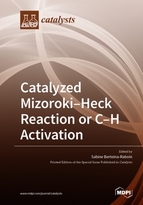Catalyzed Mizoroki–Heck Reaction or C–H activation
A special issue of Catalysts (ISSN 2073-4344). This special issue belongs to the section "Catalytic Materials".
Deadline for manuscript submissions: closed (31 March 2018) | Viewed by 67169
Special Issue Editor
Interests: methodological studies in heterocyclic chemistry; formation of C–C, C–N, C–O, and C–S bonds; synthesis or hemisynthesis of heterocyclic or bioactive molecules or natural products; environmentally friendly methods
Special Issues, Collections and Topics in MDPI journals
Special Issue Information
Dear Colleagues,
In the last few decade, researches on the elaboration by palladium-catalytic processes of C-C bonds or the C–H bonds activation has grown considerably but many improvements are still possible in terms of selectivity or even enantioselectivity via the development of new ligands or the study of the catalytic effect of other metals to carry out the same chemical transformations.The attention paid to environmentally friendly methods in terms of the quantities of catalysts, ligands and solvents is currently indispensable. The Mizoroki-Heck reaction is one of these important catalytic method to generate C-C bonds in organic synthesis and is also possible by C-H activation. This Special Issue on « Catalyze Mizoroki-Heck Reaction or C-H activation » will focus on new advances in the formation of C-C bonds via the Mizoroki-heck reaction or new C-H activation methods. In doing so we placed specific emphasis on Original research papers and short reviews on synthesis of biologically active compounds using these catalytic processes, identification of new catalysts, synthesis of new ligands allowing selectivity or énantioselectivity of the synthetic processes, activity and stability of catalyst under turnover conditions and all improvements in catalytic processes for obtaining of C-C bond or the C-H bond activation.
Prof. Dr. Sabine Berteina-Raboin
Guest Editor
Manuscript Submission Information
Manuscripts should be submitted online at www.mdpi.com by registering and logging in to this website. Once you are registered, click here to go to the submission form. Manuscripts can be submitted until the deadline. All submissions that pass pre-check are peer-reviewed. Accepted papers will be published continuously in the journal (as soon as accepted) and will be listed together on the special issue website. Research articles, review articles as well as short communications are invited. For planned papers, a title and short abstract (about 100 words) can be sent to the Editorial Office for announcement on this website.
Submitted manuscripts should not have been published previously, nor be under consideration for publication elsewhere (except conference proceedings papers). All manuscripts are thoroughly refereed through a single-blind peer-review process. A guide for authors and other relevant information for submission of manuscripts is available on the Instructions for Authors page. Catalysts is an international peer-reviewed open access monthly journal published by MDPI.
Please visit the Instructions for Authors page before submitting a manuscript. The Article Processing Charge (APC) for publication in this open access journal is 2700 CHF (Swiss Francs). Submitted papers should be well formatted and use good English. Authors may use MDPI's English editing service prior to publication or during author revisions.
Keywords
- Methodological studies in heterocyclic chemistry, formation of C-C, C-N, C-O and C-S bonds, Synthesis or hemi-synthesis of heterocyclic or bioactives molecules or natural products. environmentally friendly methods.






